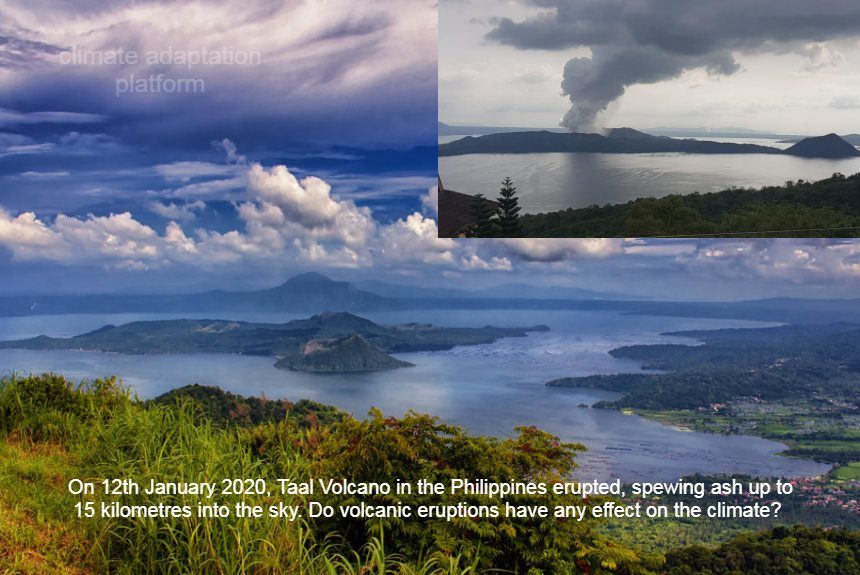Is there a link between volcanic eruptions and climate change? Do volcanic eruptions cause climate change?
On 9 December 2019, a volcano in Whaakari/White Island, New Zealand had erupted. Graham-McLay & Roy (2019) reported at least 5 people and injured up to 20 people. The White Island volcanic explosion death toll numbered 21 persons as reported on On 29 January 2020.
On 12 January 2020, Taal volcano in the Philippines erupted, spewing ash up to 15 kilometres into the sky (Philippines warns of 2020). The Philippine Institute of Volcanology and Seismology (PHIVOLCS) raised the Alert Level to 4 ( Hazardous eruption imminent), warning of the possibility of Alert Level 5 (Hazardous eruption in progress).
So far, Taal Volcano has simmered down to Alert Level 3, but authorities have warned of a possible eruption as they continue to monitor seismic activities around the area.
Sometimes forces of nature, like significant volcanic eruptions, can be so powerful and extensive that they can render human efforts pointless. For example, will the amount of carbon and gases spewed into the atmosphere from volcanic eruptions reverse all the climate change mitigation efforts (like reducing carbon emissions that people do?
Volcanic gases and ash in the atmosphere
Combining all volcanoes from land and underwater, the amounts of greenhouse gases they can release are between 100-300 million tons of C02 each year, according to the British and US Geological Survey. The figure might seem bi,g but it is only equivalent to 1 per cent of the human-caused emissions from fossil fuel. In the world of the British Geological Survey, “The contribution to the present-day atmospheric C02 loading from volcanic emissions is relatively insignificant. (How do volcanoes, 2011)
According to Skeptical Science, the claim that volcanoes emit more C02 than humans is a myth. Fossil fuel emissions per year are approximately 34 billion tonnes of carbon dioxide. This information is from the US Energy Information Administration (EIA). This amount is 100 times greater than the “maximum estimated volcanic C02 fluxes” (Do volcanoes emit, 2017).
This information makes us wonder whether the gases and carbon dioxide that volcanic eruptions release are significant compared to human-caused emissions, which cause global warming.
Effects of volcanic eruptions on Climate.
Do volcanic eruptions have any effect on the climate?
When Mt. Pinatubo erupted in the Philippines in 1999, it released 20 million tons of Sulphur dioxide and ash into the stratosphere. Gasses and ash in the atmosphere reduced the solar radiation reaching the Earth’s surface and lowered the temperature in the troposphere (Wolfe, 2019).
NASA explains that although volcanic eruptions can only last a few days, the number of gases scattered into the atmosphere can influence climate patterns for years. “Sulfuric gases convert to sulphate aerosols, sub-micron droplets containing about 75 per cent sulfuric acid. Following eruptions, these aerosol particles can linger for three to four years in the stratosphere.” Sulphate aerosols absorb terrestrial radiation, an effect known as ‘radiative forcing’ that can last up to three years after a volcanic eruption (Wolfe, 2000).
In a climate simulation from the Pinatubo eruptions, researchers have found that the presence of these sulphate aerosols in the atmosphere created a cooling effect in the troposphere, particularly in the tropical area by 4 degrees Celsius, and a winter warming in the northern hemisphere continents. However, it also causes general stratospheric heating and tropospheric warming in the winter (Wolfe, 2000).
The sulphur dioxide ejected into the stratosphere from about 10 km to 50 km from the Mt. Pinatubo eruption reacts with water and forms a hazy layer of aerosol particles. These aerosol particles are scattered around the globe through the strong stratospheric winds. Unlike the lower atmosphere (troposphere), the stratosphere does not have rain clouds to wash these pollutants. Hence, it stays there for years until the chemical and atmospheric reactions filter it out. The result is the measurable cooling of the Earth’s surface for almost two years (Global effects, n.d.).
The presence of sulphur dioxide in the stratosphere, spewed from volcanic eruptions, creates a cooling effect in the troposphere, where humans and animals live (Wolfe, 2000).
This natural event is so effective that one of the climate geoengineering techniques mimics it, a technique called solar radiation management (SRM). The SRM technique mimics volcanic eruptions to counteract the consequences of climate change, particularly the warming of the planet, by injecting sulphate aerosols into the lower stratosphere. Climate geoengineering techniques are designed as plan B if mitigation efforts to combat climate change prove unsuccessful (Geoengineering the climate, 2009).
Although volcanic eruptions cause destruction and sometimes death, they can be a solution to prevent climate change.
Source:
McLay, C.G. & Roy, E.A. (2019, December 9). New Zealand volcano: five dead after White Island eruption. The Guardian [Article]. Retrieved from https://www.theguardian.com/world/2019/dec/09/white-island-new-zealand-volcano-eruption-with-tourist-present
Philippine warns of ‘explosive eruption’ as Taal volcano spews ash. (2020, January 12). The Guardian [Article]. Retrieved from https://www.theguardian.com/world/2020/jan/12/philippines-volcano-taal-spews-ash
How do volcanoes affect the climate? (2011, February 9). The Guardian [Article]. Retrieved from https://www.theguardian.com/environment/2011/feb/09/volcanoes-climate
Do volcanoes emit more CO2 than humans? (2020). Skeptical Science. Retrieved from https://skepticalscience.com/volcanoes-and-global-warming-basic.htm
Wolfe, J. (2000, September 5). Volcanoes and Climate Change. Earth Observatory [Article]. Retrieved from https://earthobservatory.nasa.gov/features/Volcano
Global Effects of Mount Pinatubo (n.d.). Earth Observatory. Retrieved from https://earthobservatory.nasa.gov/images/1510/global-effects-of-mount-pinatubo
Geoengineering the climate. Science, governance and uncertainty. (2009, September). The Royal Society [Summary]. Retrieved from https://royalsociety.org/~/media/Royal_Society_Content/policy/publications/2009/8693.pdf



Leave a Reply